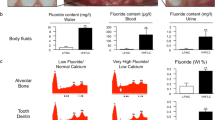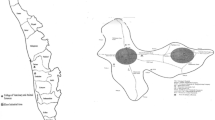Abstract
Relative susceptibility to fluoride (F) toxicosis in the form of osteo-dental fluorosis was observed in an observational survey of 2,747 mature and 887 immature domestic animals of diverse species living in areas with naturally fluoridated (>1.5 ppm F) drinking water. These animals included buffaloes (Bubalus bubalis), cattle (Bos taurus), camels (Camelus dromedarius), donkeys (Equus asinus), horses (Equus caballus), goats (Capra hircus), and sheep (Ovis aries). Of these mature and immature animals, 899 (32.7 %) and 322 (36.3 %) showed evidence of dental fluorosis with varying grades, respectively. Their incisor teeth were stained with light to deep brownish color. On clinical examination, 31.2 % mature and 10.7 % immature animals revealed periosteal exostoses, intermittent lameness, and stiffness of tendons in the legs as signs of skeletal fluorosis. The maximum susceptibility to fluoride toxicosis was found in bovines (buffaloes and cattle) followed by equines (donkeys and horses), flocks (goats and sheep), and camelids (camels). The bovine calves were found to be more sensitive and highly susceptible to F toxicosis and revealed the maximum prevalence (92.2 %) of dental fluorosis. This indicates that bovine calves are less tolerant and give early sign of F poisoning (dental fluorosis) and therefore, they can be considered as bio-indicators for fluoridated water as well as for endemicity of osteo-dental fluorosis. Causes for variation in susceptibility to F toxicosis (fluorosis) in various species of domestic animal are also discussed.





Similar content being viewed by others
References
Bornstein, S. (1990). The ship of the desert. The dromedary camel (Camelus dromedarius), a domestic animal species well adapted to extreme conditions of aridness and heat. Rangifer, 3, 231–236.
Choubisa, S. L. (1992). Molluscs as bio-indicators for the trophic stages of lakes and lotic environment. Bulletin of Pure and Applied Sciences, 11A(1–2), 97–99.
Choubisa, S. L. (1999). Some observations on endemic fluorosis in domestic animals of southern Rajasthan (India). Veterinary Research Communications, 23(7), 457–465.
Choubisa, S. L. (2001). Endemic fluorosis in southern Rajasthan (India). Fluoride, 34(1), 61–70.
Choubisa, S. L. (2007). Fluoridated ground water and its toxic effects on domestic animals residing in rural areas of Rajasthan (India). International Journal of Environmental Studies, 64(2), 151–159.
Choubisa, S. L. (2010a). Snails as bio-indicators for dreaded trematodiasis diseases. Journal of Communicable Disease, 42(3), 223–226.
Choubisa, S. L. (2010b). Osteo-dental fluorosis in horses and donkeys of Rajasthan, India. Fluoride, 43(1), 5–12.
Choubisa, S. L. (2010c). Fluorosis in dromedary camels, Rajasthan, India. Fluoride, 42(3), 194–199.
Choubisa, S. L. (2010d). Natural amelioration of fluoride toxicity (fluorosis) in goats and sheep. Current Science, 99(10), 1331–1332.
Choubisa, S. L. (2012a). Status of fluorosis in animals. Proceedings of the National Academy of Sciences, India Section B: Biological Sciences, 82(3), 331–339.
Choubisa, S. L. (2012b). Study of natural fluoride toxicity in domestic animals inhabiting arid and sub-humid ecosystems of Rajasthan [a technical report]. New Delhi: The University Grants Commission.
Choubisa, S. L. (2013a). Fluorotoxicosis in diverse species of domestic animals inhabiting areas with high fluoride in drinking water of Rajasthan, India. Proceedings of the National Academy of Sciences, India Section B: Biological Sciences, 83(3), 317–321. doi:10.1007/s40011-012-0138-6.
Choubisa, S. L. (2013b). Why desert camels are least afflicted with osteo-dental fluorosis? Current science, 105(12), 1671–1672.
Choubisa, S. L. (2013c). Fluoride toxicosis in immature herbivorous domestic animals living in low fluoride water endemic areas of Rajasthan, India: an observational survey. Fluoride, 46(1), 19–24.
Choubisa, S. L., & Sheikh, Z. (2013). Freshwater snails (Mollusca: Gastropoda) as bio-indicators for diverse ecological aquatic habitats. Cibtech Journal of Zoology, 2(3), 22–26.
Choubisa, S. L., Sompura, K., Choubisa, D. K., Pandya, H., Bhatt, S. K., Sharma, O. P., et al. (1995). Fluoride content in domestic water sources of Dungarpur district of Rajasthan. Indian Journal of Environmental Health, 37(3), 154–160.
Choubisa, S. L., Mishra, G. V., Sheikh, Z., Bhardwaj, B., Mali, P., & Jaroli, V. J. (2011a). Toxic effects of fluoride in domestic animals. Advances in Pharmacology and Toxicology, 12(2), 29–37.
Choubisa, S. L., Mishra, G. V., Sheikh, Z., Bhardwaj, B., Mali, P., & Jaroli, V. J. (2011b). Food, fluoride, and fluorosis in domestic ruminants in the Dungarpur district of Rajasthan, India. Fluoride, 44(2), 70–76.
Choubisa, S. L., Modasiya, V., Bahura, C. K., & Sheikh, Z. (2012). Toxicity of fluoride in cattle of the Indian Thar Desert, Rajasthan, India. Fluoride, 45(4), 371–376.
Cranston, P. S., Fairweather, P., & Clarke, G. (1996). Biological indicators of water quality. In Walker J and Reuter D. J. (ed) Indicators of catchment health: a technical perspective (pp. 143–154). Melbourne: C. S. I. R. O.
Druart, C., Millet, M., Scheifler, R., Delhomme, O., Reppel, C., & de Vaufleury, A. (2011). Snails as indicators of pesticide drift, deposit, transfer and effects in the vine yard. Science of Total Environment, 409(20), 4280–4288.
Ellenberg H. (1991). Bioindicators and biological monitoring. In: Ellenberg H., Arndt U., Bretthauer R., Ruthsatz B., Steubing L., editors. Biological monitoring: signal from the environment. Braunschweig: Deutsches Zentrum fur Entwicklungstechnologien- GATE, a Division of the Deutsche Gesellschaft fur Technische Zusammenarbeit (GTZ) Gmbh, and Vieweg, pp 13–74.
Hussain, J., Sharma, K. C., Ojha, K. G., & Hussian, I. (2000). Fluoride distribution in ground waters of Sirohi district in Rajasthan. Indian Journal of Environmental Ecoplanning, 3(3), 661–664.
Johnson, R. K. (1995). The indicator concept in freshwater biomonitoring. In P. S. Cranston (Ed.), Chironomids: from genes to ecosystem (pp. 11–27). Melbourne: C. S. I. R. O.
Kalisinska, E., & Palczewska-Komsa, M. (2011). Teeth of the red fox Vulpes vulpes (L., 1758) as a bioindicator in studies on fluoride pollution. Acta Theriologica, 56, 343–351. doi:10.1007/s13364-011-0039-8.
Samal, U. N., & Naik, B. N. (1992). The fluorosis problem in tropical sheep. Fluoride, 25(2), 183–190.
Shupe J. L. (1972). Clinical and pathological effects of fluoride toxicity in animals. In: Carbon- fluorine compounds; chemistry, biochemistry and biological activities. Amsterdam: Ciba Foundation, Association of Scientific Publishers. pp 357–388.
Shupe, J. L. (1980). Clinicopathological features of fluoride toxicosis in cattle. Journal of Animal Sciences, 51, 746–758.
Singh, J. L., & Swarup, D. (1995). Clinical observations and diagnosis of fluorosis in dairy cows and buffaloes: case study. Agriculture Practice, 16, 25–30.
Suttie, J. W. (1980). Nutritional aspects of fluoride toxicosis. Journal of Animal Sciences, 51, 759–766.
Swarup, D., & Dwivedi, S. K. (2002). Environmental pollution and effects of lead and fluoride and animal health. Indian Council of Agricultural Research. India: New Delhi.
Udall, D. H. (1954). The practice of veterinary medicine (6th ed., pp. 774–786). Ithaca, NY: Udall DH.
W. H. O. (2002). Environmental health criteria 227: Fluorides. Geneva: World Health Organization.
Acknowledgments
The author thanks the University Grants Commission, New Delhi, India for financial assistance [No. 34-466/2008 (SR)]. The author is also thankful to Dr. Gyan Vikas Mishra, Head of the Zoology Department, Government Girls College, Dungarpur for statistical analysis of data and to Dr. Zulfiya Sheikh, Assistant Professor of Zoology, Government Meera Girls College, Udaipur for her cooperation.
Author information
Authors and Affiliations
Corresponding author
Rights and permissions
About this article
Cite this article
Choubisa, S.L. Bovine calves as ideal bio-indicators for fluoridated drinking water and endemic osteo-dental fluorosis. Environ Monit Assess 186, 4493–4498 (2014). https://doi.org/10.1007/s10661-014-3713-x
Received:
Accepted:
Published:
Issue Date:
DOI: https://doi.org/10.1007/s10661-014-3713-x




